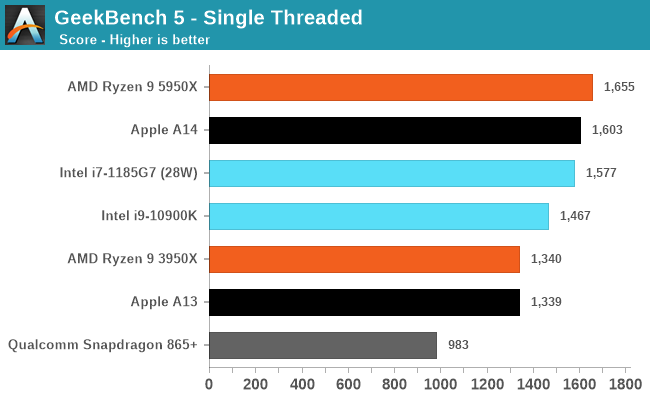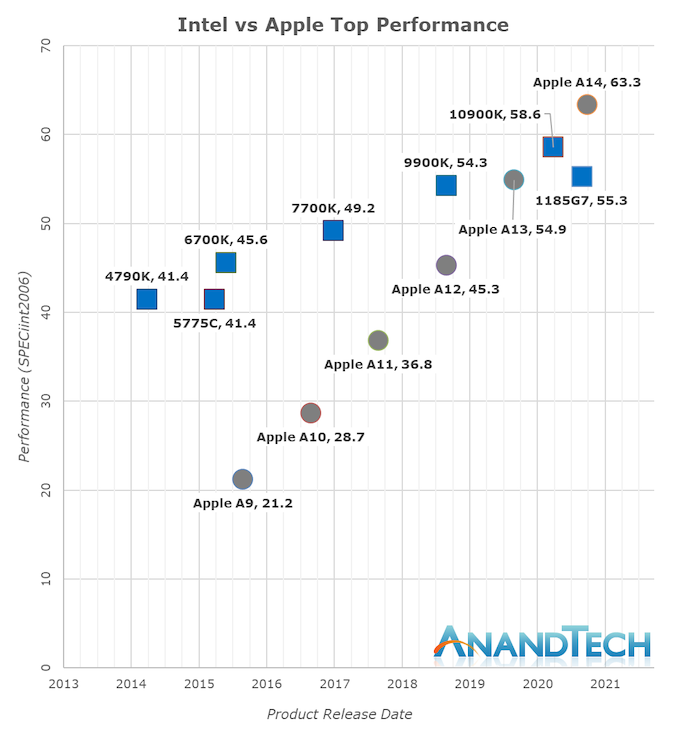Apple Announces The Apple Silicon M1: Ditching x86 - What to Expect, Based on A14
by Andrei Frumusanu on November 10, 2020 3:00 PM EST- Posted in
- Apple
- Apple A14
- Apple Silicon
- Apple M1
From Mobile to Mac: What to Expect?
To date, our performance comparisons for Apple’s chipsets have always been in the context of iPhone reviews, with the juxtaposition to x86 designs being a rather small footnote within the context of the articles. Today’s Apple Silicon launch event completely changes the narrative of what we portray in terms of performance, setting aside the typical apples vs oranges comparisons people usually argument with.
We currently do not have Apple Silicon devices and likely won’t get our hands on them for another few weeks, but we do have the A14, and expect the new Mac chips to be strongly based on the microarchitecture we’re seeing employed in the iPhone designs. Of course, we’re still comparing a phone chip versus a high-end laptop and even a high-end desktop chip, but given the performance numbers, that’s also exactly the point we’re trying to make here, setting the stage as the bare minimum of what Apple could achieve with their new Apple Silicon Mac chips.

The performance numbers of the A14 on this chart is relatively mind-boggling. If I were to release this data with the label of the A14 hidden, one would guess that the data-points came from some other x86 SKU from either AMD or Intel. The fact that the A14 currently competes with the very best top-performance designs that the x86 vendors have on the market today is just an astonishing feat.
Looking into the detailed scores, what again amazes me is the fact that the A14 not only keeps up, but actually beats both these competitors in memory-latency sensitive workloads such as 429.mcf and 471.omnetpp, even though they either have the same memory (i7-1185G7 with LPDDR4X-4266), or desktop-grade memory (5950X with DDR-3200).
Again, disregard the 456.hmmer score advantage of the A14, that’s majorly due to compiler discrepancies, subtract 33% for a more apt comparison figure.

Even in SPECfp which is even more dominated by memory heavy workloads, the A14 not only keeps up, but generally beats the Intel CPU design more often than not. AMD also wouldn’t be looking good if not for the recently released Zen3 design.

In the overall SPEC2006 chart, the A14 is performing absolutely fantastic, taking the lead in absolute performance only falling short of AMD’s recent Ryzen 5000 series.
The fact that Apple is able to achieve this in a total device power consumption of 5W including the SoC, DRAM, and regulators, versus +21W (1185G7) and 49W (5950X) package power figures, without DRAM or regulation, is absolutely mind-blowing.

There’s been a lot of criticism about more common benchmark suites such as GeekBench, but frankly I've found these concerns or arguments to be quite unfounded. The only factual differences between workloads in SPEC and workloads in GB5 is that the latter has less outlier tests which are memory-heavy, meaning it’s more of a CPU benchmark whereas SPEC has more tendency towards CPU+DRAM.
The fact that Apple does well in both workloads is evidence that they have an extremely well-balanced microarchitecture, and that Apple Silicon will be able to scale up to “desktop workloads” in terms of performance without much issue.
Where the Performance Trajectory Finally Intersects
During the release of the A7, people were pretty dismissive of the fact that Apple had called their microarchitecture a desktop-class design. People were also very dismissive of us calling the A11 and A12 reaching near desktop level performance figures a few years back, and today marks an important moment in time for the industry as Apple’s A14 now clearly is able to showcase performance that’s beyond the best that Intel can offer. It’s been a performance trajectory that’s been steadily executing and progressing for years:
Whilst in the past 5 years Intel has managed to increase their best single-thread performance by about 28%, Apple has managed to improve their designs by 198%, or 2.98x (let’s call it 3x) the performance of the Apple A9 of late 2015.
Apple’s performance trajectory and unquestioned execution over these years is what has made Apple Silicon a reality today. Anybody looking at the absurdness of that graph will realise that there simply was no other choice but for Apple to ditch Intel and x86 in favour of their own in-house microarchitecture – staying par for the course would have meant stagnation and worse consumer products.
Today’s announcements only covered Apple’s laptop-class Apple Silicon, whilst we don’t know the details at time of writing as to what Apple will be presenting, Apple’s enormous power efficiency advantage means that the new chip will be able to offer either vastly increased battery life, and/or, vastly increased performance, compared to the current Intel MacBook line-up.
Apple has claimed that they will completely transition their whole consumer line-up to Apple Silicon within two years, which is an indicator that we’ll be seeing a high-TDP many-core design to power a future Mac Pro. If the company is able to continue on their current performance trajectory, it will look extremely impressive.











644 Comments
View All Comments
mdriftmeyer - Thursday, November 12, 2020 - link
This is an utterly ignorant comment.vais - Thursday, November 12, 2020 - link
Please preorder a macbook air and run any of this years AAA games on highest settings. Take a screenshot of the FPS and post it. Those losers will cry!Or maybe you will be the one crying, who knows.
corinthos - Thursday, November 12, 2020 - link
won't need to.. i can get a ps5 or xbox series x for games.. for video editing, i'll use the measly macbook air m1 and blow away the pcmr "beasts"vais - Friday, November 13, 2020 - link
Oh yes, I bet Macbook air M1's will soon replace the crappy hardware in render farms too.MrCrispy - Thursday, November 12, 2020 - link
There is no doubt that Apple Silicon/M1 is a great technical achievement.There is also no doubt about Apple's consistent history of lies, misleading statements, consistently refusing to provide technical data or meaningful comparisons and relying on RDF/hype.
e.g. 'x86 via emulation on AS performs as fast as native x86' - complete nonsense, since they compared a 2yr old cpu, have not bothered to test any edge cases or any guarantee they can offer full backward compatibility.
Inb fact backcompat is almost 100% NOT guaranteed, as Apple in general scoffs at the concept and has never bothered to engineer it unlike Microsoft, and companies with much more experience e.g. Microsoft/IBM have failed to provide it when they tried.
Will an M1 MBP be faster than the latest Ryzen/Intel desktop class cpu in any general purpose computing task, in all perf bands and not just in burst mode, whilst having 2x battery life, AND provide perfect emulation for any x86 app including 30-40 years of legacy code - highly doubtful.
And even if it does it comes at a massive price premium, completely locked hardware and software, no upgrade or servicing or any reuse/recycling at all, extremely bad for environment.
Apple is the very definition of a closed, anti-consumer, for profit company. Do I want the massive plethora of x86 pc's at every possible price range to disappear in favor of $$$$$$ Apple products that exclude 99% of thr world population - hell no !!
andynormancx - Thursday, November 12, 2020 - link
Apple aren't claiming 100% backwards compatibility with all x86 code, they don't need to support "30-40 years of legacy code" and they aren't saying they are going to.For a start they are only support 64 bit x86 code, they don't need to support 32 bit code as they already depreciated support for that in the last version of MacOS (no doubt partly to support the x86 - ARM transition).
They have also said that some instructions won't be supported, I think it was some of the vector based ones.
It of course isn't Apple's first time to do this either. They had the very successfully PowerPC to Intel emulation when they moved to Intel. People including me ran lots of PowerPC apps on Intel for several years, it worked very well.
andynormancx - Thursday, November 12, 2020 - link
I should say that emulation isn't really the right word to be using. Rosetta 2 isn't really attempting to model the inner workings of a x86 chip.It is translating the x86 code to equivalent ARM code when the app is first run. This includes wiring it up to the equivalent native ARM versions of any system frameworks the app uses. So apps that spend a lot of time in native non-translated ARM code for a lot of their run time.
For things like games that use the Metal GPU framework extensively, there is every chance that they _could_ end up running faster on the new ARM machines with their translated code than they did in the outgoing x86 MacBooks.
andynormancx - Thursday, November 12, 2020 - link
Microsoft have posted that x86 Office 2019 works on the ARM translation and "There are no feature differences". And for performance they say "The first launch of each Office app will take longer as the operating system has to generate optimized code for the Apple Silicon processor. Users will notice that the apps 'bounce' in the dock for approximately 20 seconds while this process completes. Subsequent app launches will be fast."https://support.microsoft.com/en-us/office/microso...
MrCrispy - Thursday, November 12, 2020 - link
I understand Rosetta 2 won't support virtualization or AVX, thats fine. The question is will an x86 app run identically on an Intel and AS MBP? I don't know how much demand there is going to be for this as Apple is pretty strict about forcing devs to upgrade to latest, and app developers will be quick to claim 'natively runs on AS' badges which I'm sure will forthcoming.The question of speed still remains. When does embargo lift on M1 MBP reviews?
Also M1 will not be able run a VM. MBPs are very popular with devs and running VMs is a big part of that.
andynormancx - Thursday, November 12, 2020 - link
There will be plenty of demand for it. There will be plenty of apps that with take months or years to get updated fully and plenty that never get updated (though admittedly quite a few of those probably went away with the 32 bit depreciation).The embargo will typically lift the day before people starting receiving the first orders. So probably on Monday.
Not being able to run x86 in a VM will certainly be a disadvantage for some people. I would have been one of those people until four years ago, I spent a lot of time in VirtualBox running Visual Studio on my Mac. An ARM laptop certainly wouldn't have been an attractive option for me then.
There will I'm sure be truly emulated options, to run Windows/Linux in x86 on Apple Silicon, but then of course that will have a whole different level of performance overhead. If I need to run x86 Windows on my ARM Mac, when I have one, I expect I'll opt for a VM in the cloud instead.
Also, I'm sure if performance under Rosetta 2 was bad then there would have been mutterings from the developers who've had the A12X based machines, NDA or no NDA...